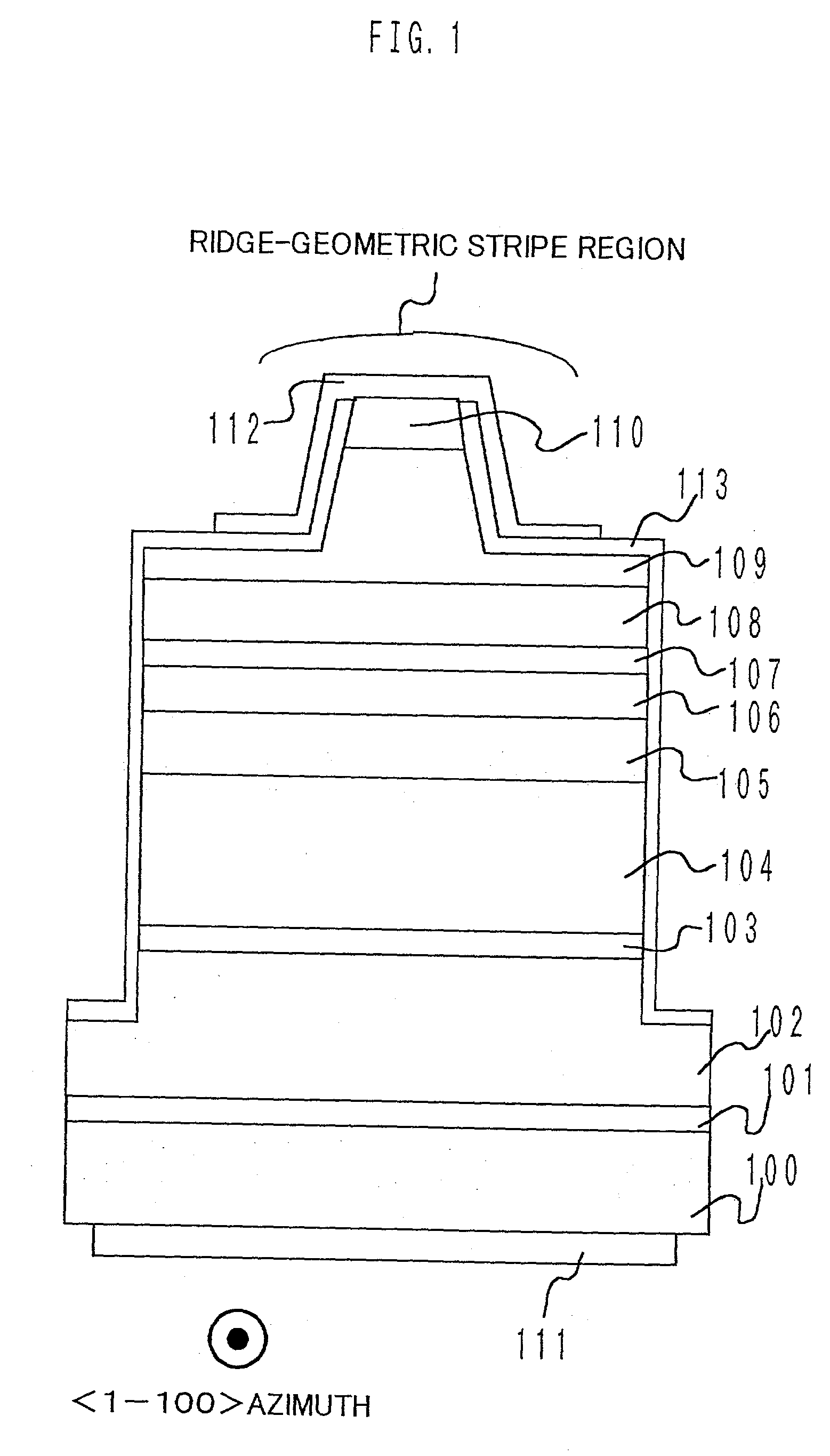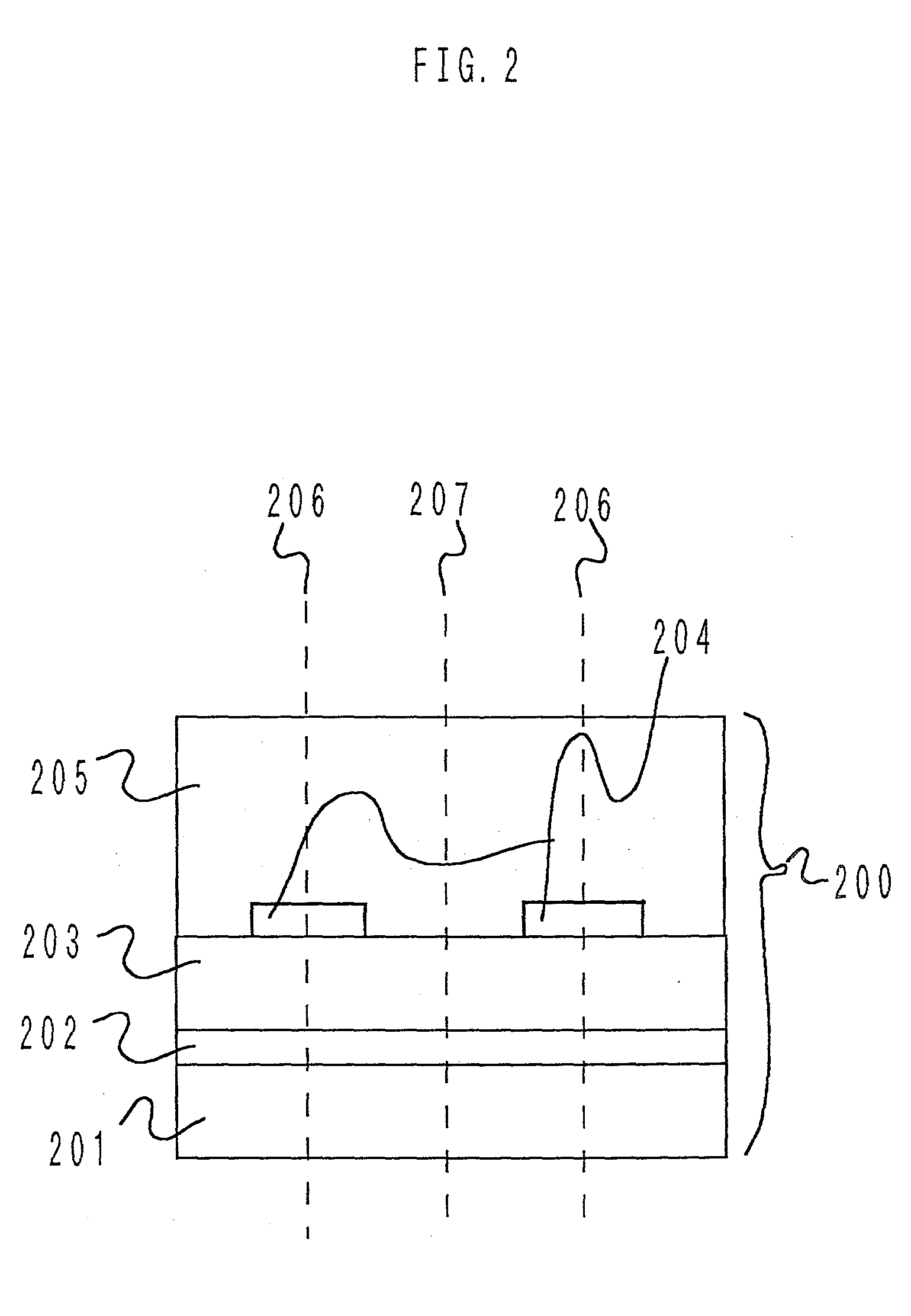Nitride semiconductor light-emitting device and opticfal device and light-emitting apparatus with the nitride semiconductor light-emitting device
- Summary
- Abstract
- Description
- Claims
- Application Information
AI Technical Summary
Benefits of technology
Problems solved by technology
Method used
Image
Examples
embodiment 2
[0071] In the device shown in FIG. 1, GaN substrate 100 is replaced with a pseudo GaN substrate 200 shown in FIG. 2 or a pseudo GaN substrate 200a shown in FIG. 3B, and an n-type electrode is formed on one side of the device as shown in FIG. 4. A nitride semiconductor laser device is accordingly fabricated similarly to Embodiment 1 except for above details.
[0072] Pseudo GaN substrate 200 shown in FIG. 2 is constituted of a seed substrate 201, and a low temperature buffer layer 202, an n-type GaN layer 203, an anti-growth layer 204 and an n-type GaN thick layer 205 that are formed on seed substrate 201. Seed substrate 201 is used as a parent material on which n-type GaN thick layer 205 is grown. Anti-growth layer 204 is used for preventing the nitride semiconductor crystal layer from growing directly on the underlayer. Crystal growth through anti-growth layer 204 allows the growth to selectively be done in a specific crystal orientation. Any pseudo GaN substrate except for the one sh...
embodiment 3
[0082] According to this embodiment, a nitride semiconductor laser device is produced in a similar manner to that of Embodiment 1 except that the nitride semiconductor laser device is formed on a hetero-substrate with a nitride semiconductor buffer layer therebetween and that an n-type electrode is formed on one side as shown in FIG. 4. The nitride semiconductor laser device thus produced has the structure as shown in FIG. 4 and includes a substrate 300, a low temperature GaN buffer layer 101 (thickness 25 nm), and n-type GaN layer 102, an n-type In.sub.0.07Ga.sub.0.93N anti-crack layer 103, an n-type Al.sub.0.1Ga.sub.0.9N cladding layer 104, an n-type GaN optical guide layer 105, a light-emitting layer 106, a p-type Al.sub.0.2Ga.sub.0.8N carrier blocking layer 107, a p-type GaN optical guide layer 108, a p-type Al.sub.0.1Ga.sub.0.9N cladding layer 109, a p-type GaN contact layer 110, an n-type electrode 111, a p-type electrode 112, and an SiO.sub.2 dielectric layer 113. Here, subst...
embodiment 4
[0085] A nitride light-emitting diode device is provided according to this embodiment. The light-emitting diode device shown in FIG. 5 includes an n-type GaN substrate 600 having C-plane (0001), a low temperature GaN buffer layer 601 (thickness 100 nm), an n-type GaN layer 602 (thickness 3 .mu.m, Si impurity concentration 1.times.10.sup.18 / cm.sup.3), a light-emitting layer 603 (5 cycles of GaN.sub.0.97As.sub.0.03 well layer (thickness 3.1 nm) / GaN barrier layer (thickness 6 nm)), a p-type Al.sub.0.1Ga.sub.0.9N carrier blocking layer 604 (thickness 20 nm, Mg impurity concentration 6.times.10.sup.19 / cm.sup.3), a p-type GaN contact layer 605 (thickness 0.1 .mu.m, Mg impurity concentration 1.times.10.sup.20 / cm.sup.3), a light-transmissive electrode 606, a p-type electrode 607, and an n-type electrode 608.
[0086] According to this embodiment, n-type electrode 608 is formed on the rear side of n-type GaN substrate 600 in the order of Hf / Al. Instead of this material for the n-type electrode,...
PUM
 Login to View More
Login to View More Abstract
Description
Claims
Application Information
 Login to View More
Login to View More - R&D
- Intellectual Property
- Life Sciences
- Materials
- Tech Scout
- Unparalleled Data Quality
- Higher Quality Content
- 60% Fewer Hallucinations
Browse by: Latest US Patents, China's latest patents, Technical Efficacy Thesaurus, Application Domain, Technology Topic, Popular Technical Reports.
© 2025 PatSnap. All rights reserved.Legal|Privacy policy|Modern Slavery Act Transparency Statement|Sitemap|About US| Contact US: help@patsnap.com



